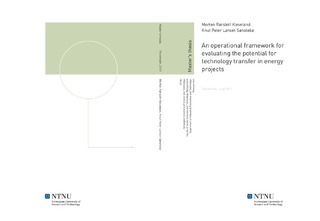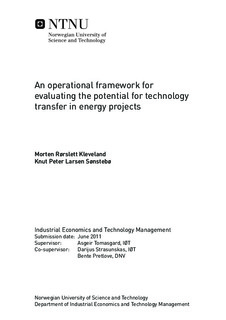| dc.description.abstract | The purpose of this work has been to develop a generic framework with a set of indicators, suited for ensuring that technology will be successfully transferred. It was stressed that the framework should be generic, as it should be suitable for projects with differing technologies, locations and environments. Methodology:The development of the indicators followed a systematic and rigorous process, starting with formulation of visions, sub-visions and goals for successful technology transfer. The formulation was completed in the specialisation project during the autumn 2010. The indicators were then prepared in response to the formulated goals, and categorized within either the social, institutional, environmental, business or technological dimension. The indicators are for practical purposes gathered in a Protocol, which provides a complete tool for considering technology transfer on the project level. To further operationalize the Protocol, a technology-specific set of indicators was called for. As a response, one indicator set for hydropower, and one indicator set for wind power is prepared. The indicator development was an iterative process, where the indicators were reviewed by experts and tested on ongoing projects. Firstly, a Delphi Survey was conducted, with academics and practitioners within the fields of international energy production and technology transfer. The survey had 12 respondents from 11 different organisations. Secondly, the validity of the indicator set was attempted indicated by comparing the result of using the Protocol, with the observed technology transfer track record for two operating projects. Results:The Delphi Survey showed that the experts agreed that the indicators for assessing technology transfer potential in general were of high quality, and their suggestions for further improvements were later implemented. The case studies showed that the results of using the Protocol indeed correlated with the observed technology transfer in both projects. However, this is only regarded as an indication of the validity of the Protocol, not as a rigorous proof. Conclusion and further work: The work with this thesis has culminated in a Protocol for assessing the potential for technology transfer in energy projects. The indicators are thoroughly reviewed and applied. To further validate the Protocol as a tool predicting technology transfer, an extensive study should be conducted with a large number of projects, where the results from applying the Protocol in the early stages are compared with the observed technology transfer. Additionally, more technology-specific indicator sets could be prepared for other forms of energy production technologies. | nb_NO |

